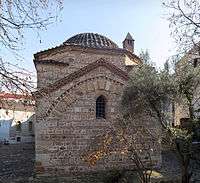Evrenos
Evrenos or Evrenuz (Gazi Hadji Evrenos Bey; died 17 November 1417 in Yenice-i Vardar) was an Ottoman military commander, with an unlikely long-lived career and lifetime. He served as a general under Süleyman Pasha, Murad I, Bayezid I, Süleyman Çelebi and Mehmed I.[1]
Evrenos | |
|---|---|
| Nickname(s) | Gazi Baba |
| Born | Karasid Emirate |
| Died | 17 November 1417 Yenice-i Vardar |
| Buried | |
| Allegiance | |
| Battles/wars | Battle of Kosovo (1389) Battle of Nicopolis (1396) Evrenos conquered Keşan, İpsala, Komotini, Feres, Xanthi, Maroneia, Serres, Monastir, and, in 1397, Corinth |



Byzantine sources mention him as Εβρενός, Ἀβρανέζης, Βρανέζης, Βρανεύς (?), Βρενέζ, Βρενέζης, Βρενές.[2] A persistent Greek legend maintains that Evrenos' father was a certain Ornos, renegade Byzantine governor of Bursa who defected to the Ottomans, and then on to Karasi, after the Siege of Bursa, in 1326.[3] He was known as Isa Bey Prangi, buried in the village of Prangi (also known as Sırcık or Kırcık in Ottoman sources), a busy ferry-place on the Evros river about 6 km (4 mi) east from Didymoteicho.[4] Stanford J. Shaw and Joseph von Hammer regard Evrenos as a Byzantine convert to Islam.[5][6]
Οriginally, Gazi Evrenos was a noble dignitary, a bey in the principality of Karasi, joining the Ottomans only after their conquest of the beylik in 1345. He led many crucial Ottoman campaigns and battles in Bulgaria, Thessaly, and Serbia. After having participated in the Ottoman conquest of Adrianopolis in 1362, Evrenos was appointed to uc beği (frontier warlord) of Thessaly.[2] He and his akıncıs fought in the Battle of Kosovo (1389) and the Battle of Nicopolis (1396). Evrenos conquered Keşan, İpsala, Komotini, Feres, Xanthi, Maroneia, Serres, Monastir, and, in 1397, Corinth.[1][7] He founded the town Yenice-i Vardar, modern Giannitsa.[8] The inhabitants of Gianitsa (Ottoman: Yenice Vardar) down to the early 20th century displayed reverence for "Gazi Baba", that is "papa Gazi".
Gazi Evrenos Bey was father of seven sons (Khidr-shah, Isa, Suleyman, Ali, Yakub, Barak, Begdje) and several daughters.[9] Among the numerous descendants of lord Gazi Evrenos, apparently the memory of some has dived into oblivion, as their deeds got incorporated into the achievements of their illustrious forefather. This explains the legendary, yet unlikely, 129-year lifespan of lord Gazi.
Together with the Mihaloğulları (from the Karasi emirate), Malkoçoğulları (from Serbia), Ömerli/Ömeroğlu, and the Turahanoğulları, Evrenos' descendants, the Evrenosoğulları, constitute one of the Byzantine families that effectively formed the early Ottoman warrior nobility.[7]
Gazi Evrenos died at an advanced age in Yenice-i Vardar. He was buried in a mausoleum there in 1417. The mausoleum survives but was badly mutilated in 19th century and served for a time as an agricultural store.[4]
As one of the most successful Ottoman commanders, Evrenos acquired a considerable amount of wealth and founded numerous endowments (awqaf). Several monuments attributed to him survive in southeastern Europe. Of primary importance is his mausoleum, or türbe, with its accompanying epitaph in Giannitsa.[4] A hammam of Evrenos stands to the south of the mausoleum. Two other monuments stand in Greek Thrace.[10]
References
- Reinert, Steven W. (1991). "Evrenos". Oxford Dictionary of Byzantium. 2. New York/Oxford: Oxford University Press. p. 765.
- Trapp, Erich; Walther, Rainer; Beyer, Hans-Veit; Sturm-Schnabl, Katja (1978). "Ἐβρενέζ". Prosopographisches Lexikon der Palaiologenzeit (in German). 3. Vienna: Verlag der Österreichischen Akademie der Wissenschaften. pp. 207–208. ISBN 3-7001-3003-1.
- P. Voutierides, “Neai Ellenikai Poleis-Yenitsa” Panathinaia 25 (1912-13), p. 210.
- Demetriades, Vasilis (1976). "The Tomb of Ghāzī Evrenos Bey at Yenitsa and Its Inscription". Bulletin of the School of Oriental and African Studies, University of London. 39 (2): 328–332. doi:10.1017/S0041977X00050023. ISSN 0041-977X. JSTOR 616797.
- Stanford J. Shaw: History of the Ottoman Empire and Modern Turkey. Volume 1, Empire of the Gazis: The Rise and Decline of the Ottoman Empire 1280–1808. Cambridge University Press, 1977.
- Joseph von Hammer: Geschichte des Osmanischen Reiches. Zweite verbesserte Ausgabe Bd. I - IV. Hartlebens, Pesth 1836. (Serbo-Croatian edition by Nerkez Smailagić. Zagreb, 1979.)
- Mélikoff, I. (1991). "Ewrenos". Encyclopaedia of Islam. II (2nd ed.). Leiden: E. J. Brill. p. 720.
- Machiel Kiel, "Yenice Vardar (Vardar Yenicesi-Giannitsa): A forgotten Turkish cultural centre in Macedonia of the 15th and 16th century,” Studia Byzantina et Neohellenica Neerlandica 3 (1973): 303.
- Mélikoff, I. (1991). "Evrenos Oghullari". Encyclopaedia of Islam. II (2nd ed.). Leiden: E. J. Brill. p. 720.
- Machiel Kiel, “The Oldest Monuments of Ottoman-Turkish Architecture in the Balkans: The Imaret and the Mosque of Ghazi Evrenos Bey in Gümülcine (Komotini) and the Evrenos Bey Khan in the Village of Ilıca/Loutra in Greek Thrace” Sanat Tarihi Yıllıġı, Kunsthhistorische Forschungen 12 (Istanbul, 1983): pp. 117-138.
External links
- Mausoleum of Gazi Evrenos in Giannitsa (Yenitsa), Greece.
See also
- Lala Shahin Pasha
- Çandarlı Kara Halil Hayreddin Pasha
- Umur the Lion